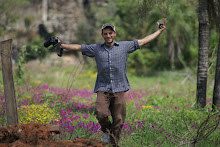


The Panama Canal has cut through the Central American isthmus and connected the Caribbean and Pacific Ocean for a century. This morning a small cadre of dedicated athletes swam through it, biked over it and ran along side it.
In hosting its first ever ‘half ironman’ -a 1.2 mile swim, 59 mile bike, and 13.1 mile run— the City of Panama turned over this iconic venue –a sea level canal framed by the juxtaposition of jungle covered hills and gleaming skyscrapers— to top flight triathletes and endurance amateurs alike.
As cargo ships steamed north toward the Miraflores Locks, swimmers’ arms rose and fell with disciplined cadence in the canal’s current as they entered the Pacific. Transforming themselves into cyclists, the triathletes rode over the Bridge of the Americas –the first bridge to span the canal– for a thirty-mile there and back. Trading wheels once more for pure human locomotion, the triathletes ran the remainder of the race on a ribbon thin causeway constructed from the canal’s excavation.
One Lance Armstrong –seven time winner of the Tour de France and cancer survivor- graced the race with his presence; immediately granting the inaugural competition with prestige and worldwide recognition. With the carriage of a Greek god, Armstrong held the lead until the final moments when a New Zealand competitor bested him.
Panama, home to three million inhabitants stuck to a jungle green landmass shaped like a stick of gum, is stretched by contradiction and cultural complexity. Boasting a $5.25 billion dollar canal amplification project for a waterway that generates millions of dollars in weekly revenue and a highly developed financial sector, Panama still harbors a subsistence farming, lack of potable water poverty rate of ~15%. In addition, expanding American Baby Boomers’ beachfront enclaves now but up against autonomous indigenous regions of the Ngabe Bugle, Kuna Yala, Wounaan and Embera who have managed to maintain their distinctive, centuries old cultural traditions.
Much like the efforts of any triathlete. Investment in expensive, technologically advanced equipment (feather weight shoes, carbon fiber bikes, enlarged canal locks) can only take Panama’s social and economic development so far. It is only the huge human component which makes success achievable: the hours of countless physical training, the extraordinary effort needed to execute community level capacity building programs.
The original fitness guru Jake Lalane is famous for saying: “Train for life as if it were an Olympic event.” Today’s triathletes epitomized this statement. Panama's development efforts should take note. Hosting its first half ironman is a good start, but completing the competition and improving the quality of life of its citizens is a whole different challenge.
